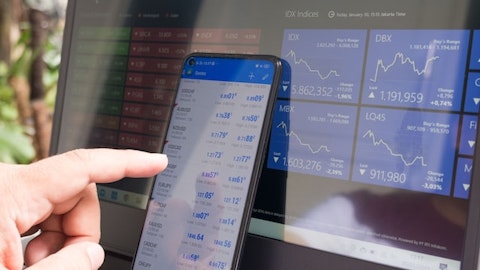Gary Smith: The answer to your last question is yes, George (sic) [Simon]. I would say on the hyperscalers, just to remind everybody, I mean, we’re close to 40% revenue growth with these guys this year. So, despite the sort of public issues around your efficiency and all the rest of it, they’re still clearly prioritizing network because that’s the lifeblood for them, regardless of what the applications happen in their data center, it lives when it gets into the network into the cloud. So, we’ve not seen really any back off in terms of their commitment to build out the networks for that very reason. And I think if you look at the dynamics around machine learning and AI, et cetera, and who knows how that will play out and the timing of it and the modeling of the network piece.
But you have to believe that that traffic will be incremental to what we’ve already seen over some point in time here. So, we’re not seeing any let up from the cloud players. We’ve got a lot of backlog that Jim talked about for a proportion of that is cloud providers that they want as we go through next year. So, we expect to have a strong year with them next year. Now, because of the rule of large numbers, it’s not going to be 40% growth at that rate, but we still expect a very strong year from the cloud providers.
Simon Leopold: Great. And then just a quick follow-up. Remaining performance obligations, where are they now and how did they trend in the quarter versus the prior?
Jim Moylan: They are slightly down, but still strong.
Simon Leopold: Okay. Thank you.
Jim Moylan: $2.1 billion from $2.4 billion.
Operator: [Operator Instructions] Our next question today will come from Michael Genovese of Rosenblatt Securities. Please go ahead.
Michael Genovese: Congratulations on the improving outlook here, or actually consistent outlook, I should say. But in terms of the three-year CAGR, as we talk about ‘24 versus ‘25, are you thinking about those years being fairly even with each other, or is there a reason, for instance, ‘24 would be lower coming off the strength of ‘23? Thank you.
Jim Moylan: All I’d say today is that we said the average over the next three years is going to be 10% to 12%. And you can back into what the average rate of growth is in ‘24 and ‘25 to get to that 10% to 12% based on whatever you think we’re going to do for this year. Speculating on how it trends between those two years is not something we’re going to do right now, Mike.
Michael Genovese: Okay. Well, I take that to be a good thing, meaning that there’s confidence in ‘24. That’s it for me. Thanks guys.
Gary Smith: Thanks, Mike.
Operator: And our next question today will come from Samik Chatterjee of JP Morgan. Please go ahead.
Samik Chatterjee: I have a couple. But maybe if I can start with the growth outlook or just the comments that you made that next year will be a growth year. And not to get into specifics, but how much of that confidence should I interpret as coming from the recent uptick that you’re seeing in cloud orders, or is there a conference given sort of the activity you’re seeing outside the Tier 1 telcos as well, the telco as well as the vertical grows next year? Any thoughts around that, please? And then I have a quick follow-up.
Jim Moylan: The way Gary described demand, I think, captures our confidence, because we said that it’s a combination of pipeline, which is customer activity, and customer activity is very strong. We’re in conversations with a lot of customers around the world for what they want to do next year. And we’re in the middle of a lot of equivalent to RFP. So, first of all, activity is strong. Secondly, we did start to see a trend upward in orders, and they were from the web-scale players. And thirdly, we expect a lot of that backlog, which still remains high to convert to revenue next year. So, it’s really all three elements of demand that we feel very good about, Samik.
Samik Chatterjee: And Jim, I guess the follow-up was for you in terms of — you’re sticking to your 10% to 12% three-year outlook, which sort of means that generally, the other parts of that plan should hold. When we think about inventory that you want to carry through that plan, how does that compare to what you were sort of carrying pre-pandemic, which was more like $300 million or so and right now, you’re tracking by the end of the year, about $900 million plus? So, how are you thinking about, like is that plan still intact to get back to a pre-pandemic level, how do you want to plan around inventory exiting that window?
Jim Moylan: Yes. Without commenting on what our revenue is going to be next year, we do expect a good year, and we do expect our inventory levels to come down very significantly next year. That’s our expectation as we sit here today. I won’t give you an exact number. I will say that given what the supply chain has gone through and the changes in the supply chain that we will likely carry a bit more inventory as compared to revenue than we have in the past. You’ll recall that we used to — for many quarters, we ran at about 6 turns. I don’t believe, given our need for buffer stocks going forward that we will run at 6 times. The question is where we end up below that, and it’s probably going to be between 4 and 5 times. I don’t know exactly where in that range. But that means that that inventory will come down next year, we believe.
Operator: Our next question today will come from Alex Henderson of Needham. Please go ahead.
Alex Henderson: So clearly, the optical line systems was a key driver of shipments in the period, and those carry significantly lower margins. They often generate future orders of transceivers two, three quarters, four quarters out. So, can you talk about how you think the mix of the shipments will change over time as you’ve been shipping out the optical line systems here, and whether that implies some improvement in the margins in the forward periods as the mix shifts to transceivers going forward? Should we expect a couple of hundred basis points of margin expansion at some point over the next year?
Gary Smith: I would say this, Alex. I mean, I think the dynamic that you highlighted is exactly the right one. I mean, it’s very encouraging that we’re putting all this track out there basically. And RLS — the adoption of RLS has been terrific. And we’re now in a position where we can ship it in large scale. So, I think that’s very encouraging because that will translate into modems over time. And I would expect — again, we’re not in a position to sort of guide for next year, but I would expect generally improving margins because of this dynamic. And also, you haven’t got the associated cost of the supply chain is beginning to ameliorate. So I think the combination of those two things, a better mix overall from a margin point of view, as we take advantage to all the track that we’re laying plus a little bit more of a normalization of costs from a supply chain point of view should point to higher gross margins going forward.
Alex Henderson: So, could you quantify the impact of the supply chain on ‘23 gross margins?



